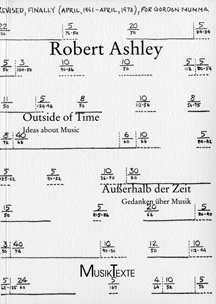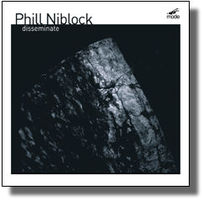We have recently – about fifty years ago – come upon a new idea in thinking about music, but I think it is not even approached in theory. This new idea does not use the
timeline score….ÂBy timeline music I mean music having any number of parts, a piano score or an orchestra score, that are coordinated by bar lines. This music must, by definition, be
“linear.”…ÂCuriously, the most famous proponents – for Europeans and Asians as well as Americans – of a new kind of music among American composers, John Cage and Morton Feldman, could not escape from the timeline practice. They made wild (sometimes seemingly desperate) attempts to make a new kind of music, but their attempts were fundamentally still trapped in the timeline way of thinking. (I don’t mean that their music was unsuccessful… I mean that to attribute to these two composers
the kind of radical departure that one recognizes in Wolff or Brown, Behrman,
Lucier, Amacher, Niblock, my own music and a few younger composers, is wrong.)ÂFor everybody else who appeared around 1960 and is still around – Babbitt, Wuorinen, Reynolds, and countless others – there is no question that they ignored the message and continued exploring the timeline.Â
The first evidence of the non-timeline music came around 1960. (Typically, it was around earlier – especially in Wolff and Brown – but it really began to “flower” after 1960. It is hard to know whether Wolff or Brown realized what they were doing to the
history of music. This is not to detract at all from their work – or their intelligence about their work – but, as I have maintained, the manifestation of an idea seems to happen before the idea is recognized and described….)ÂAnother “historical” fact to be recognized is that the reaction to the practice of non-timeline music, particularly in the form of “minimalism” and “postromanticism,” came not more than ten years after a lot of composers started doing non-timeline music. In other words, non-timeline music was very important and, in the case of the reaction to it, something
perhaps to be feared. As if some composers were leading us in the wrong
direction and things had to be corrected.ÂIt’s true, of
course, that “time” passes while music is being played and while it is being
listened to. But in non-timeline music (the drone) the time passing is not
“attached to” the playing or the hearing. Time passes in the consciousness of
the listener according to internal or external markers.ÂThe feeling of
timelessness can be created in a traditional timeline score using an extreme
version of the timeline technique. That is, by pushing the timeline technique
to an extreme of what can be written in a timeline score, I remember this,
without being able to cite examples, from certain Earle Brown scores. The one
example I can cite is Somei Satoh’s Kyokoku. In this score for voice and orchestra
Satoh uses a very slow tempo (twenty beats per minute) and allows that in
certain sustained sections the conductor can slow the tempo even more, or can
stop the tempo entirely. In these sections the feeling of timelessness is
evoked….ÂNon-timeline makes
no attempt to keep the attention of the listener. It exists as if apart from
the attention of the listener. The listener is free to come and go. When the
listener attends to the music, there is only the “sound.” The sound is
everything. When the listener is away, the music exists anyway. This is
certainly a new idea….ÂI have called this
new idea the “drone,” because there is no better term that is not a neologism –
like non-timeline music. I have said that I use the term “drone” to mean any
music that seems not to change over time.
Or music that
changes so slowly that the changes are almost imperceptible. Many composers
make this kind of music. The best known to me, offhand, are Behrman, Lucier, Radigue,
Tone, Payne, Bischoff, Hamilton, along with others.ÂOr music that has
so many repetitions of the same melodic-harmonic pattern that the pattern is
clearly secondary to another aspect of the form. Philip Glass’s early music is
a good example. (Glass recently has more and more reverted to the timeline
style.)ÂThe non-timeline
concept has permeated my music, though because of my deep involvement with
speech rhythms and opera, I have not composed much music that is pure
non-tineline.
My early music –
prior to 1980 – is much more clearly exploring the non-timeline concept. After
1980, when opera became the most important fact of my work, I began using
certain aspects of the traditional score to coordinate many performers’ actions
(musical events) at any moment in the linear time pattern. I am still trying to
escape from that constraint, but so far unsuccessfully….ÂWhat is in the
nature of non-timeline music in the operas is the technique of allowing the
harmony to continue for so long in a particular aria that harmony loses its
traditional meaning….ÂThe purpose is to
create an intense self-consciousness in the listener, a kind of “meditative”
state of mind. Of course, as in meditation, as I understand it, the attention
in the listener will change constantly and is the responsibility of the
listener. The composition exists “apart from” the listener, a musical fact to
be observed and appreciated at the will of the listener….ÂIn a simplistic
explanation of “non-timeline” music the composer’s purpose is dedicated to the sound of the work. The sound is everything. The
sound has no temporal dimensions. It exists apart from the listener’s
participation. In non-timeline music nothing happens. The sound is simply
there. [Variations on the “Drone,” 2004; pp. 114-124]Â
Ashley’s liner notes to Phill Niblock’s Disseminate CD (Mode 131):Â
The “drone” is one
of the special contributions to musical technique in the second half of the 20th century. I use the term “drone” – though most composers who will be named below
will resent the term – because I can’t invent another term or phrase that is
not just musical jargon and that is not more understandable.ÂThe drone has two
pronounced characteristics. The first and most obvious is an unchanging, or
barely changing, pitch. This characteristic, notably, is also the rarest among
various composers’ “signatures.” Most composers moved away from the unchanging
pitch technique almost as soon as they got involved with the drone….ÂFundamentally the
drone disregards pitch change. And so the musical time seems to stop. This lack
of eventfulness is a challenge to the listener that the composer of any form of
drone music must live with (and/or “solve” by some other technique)….ÂA second
characteristic of the drone, but I think part of the same tendency, is a
quality of unchanging tonal “color”; that is, an unchanging instrumental sound,
regardless of what other elements of musical composition are employed. One
could name any number (a large number) of composers who work in this area.
These composers have abandoned the “narrative” or “dramatic” notion of the
orchestra as a collection of “characters”….The drone seems
peculiarly American. The reasons are probably many.ÂNo American
ensemble would play any living composer’s music in the 1950s, and so any new
technique that deviated from the performer’s conservatory training was
discouraged. One could call that situation a form of poverty (for the composer)
and a deciding factor in the invention of a new technique. But, of course,
historically poverty has produced a lot of changes in music.ÂAnother reason, I
believe, was the American composer’s unusual interest in the music of other
cultures, particularly (because they were available on records) the various
musics of Southeast Asia, the various musics of Africa and the various musics
of the marginal black and marginal white isolated cultures in the United
States. And all of these musics seemed to have fewer “changes” and a simpler
“architecture” than the music we had inherited from the concert stages of
Europe.ÂBut most important,
I think, was the advent of electronic music. Prior to the use of electricity
the energy source for music was physical (human) and the limitations on that
energy source had to be accommodated in the music. The music had to rest, had
to be softer for awhile, had occasionally to be texturally less dense. With a
new source of energy coming from the local utility company all of that changed.
Conceptually, the music could go on at any level of intensity forever….Â
excerpting from much longer articles I haven’t created a false impression of
any of Bob’s ideas. Those inclined to criticize might want to consult the
complete originals before so doing. We have a paucity of narratives for what’s happened in music in the last 60 years, and this one, from one of the era’s major
players, is particularly valuable. I’ve written my own narrative, of course,
which Bob’s conflicts with at several points. Of particular interest is that,
having come from the revolutionary, score-rejecting ONCE festival scene of the
’60s, he lumps much minimalist music into the conservative reaction against that scene. Coming along myself in
the ’70s, I think of the ’60s, ’70s, and early ’80s as the great liberal era in
music’s history, whereas for Bob the ’70s were already a turning back towards
comforting convention. Not having been there, I can only honor his perspective.
importance is his concept of the drone, which does indeed draw a sharp line through the group of
composers lumped into the generic term minimalism, separating traditional
timeline composers like Andriessen and Adams off from the more radical
composers like Niblock and Behrman (and Charlemagne Palestine? though Bob never
mentions him) who compose unchanging (or slowly changing) sounds. This division
is one the Society for Minimalist Music will want to confront at some point. I
hope to bring this Ashleyan critique to bear in my contribution to our 2011
conference in Leuven. Whenever someone tells me that someone they know in
academia is “sympathetic to minimalism,” I always wonder: you mean simply that
they’ve learned to re-accept diatonicism in timeline music? or have they realized that a piece of music need not contain any events? If only the first, I’m not impressed.
music is less radical than the music Bob champions in these descriptions.
After some early forays into Riley-like free repetition, I became rather
addicted to the timeline. I’ve always been more interested in refining our
perception of pitch and rhythm within a conventional format than in larger
exploration of form and modes of listening. And yet I sometimes – I could cite
my pieces Solitaire, Kierkegaard Walking, Implausible Sketches, Time Does Not
Exist, Cosmic Boogie-Woogie – use the timeline to create what I think of as a drone-like effect, in
which the continuing sound
of a melodic complex changes internally but not externally, and the linear
succession of sound complexes, if any, is almost arbitrary, as in the old joke “Time is
God’s way of keeping everything from happening all at once.” Bob’s
categories are different from mine but compelling, and give me a lot of food
for thought. I hope they do for you too.)


